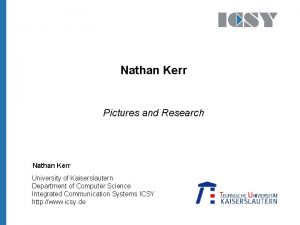OT and JXNLSoar Nathan Glenn Nathan g glenngmail








- Slides: 8

OT and JXNL-Soar Nathan Glenn Nathan. g. glenn@gmail. com BYU

Optimality Theory � Is a method of predicting linguistic or other behavior using ranked violable constraints � Good for predicting linguistic phenomena, cross-linguistic and dialectic variation � Currently biggest use is in phonology ◦ Also used for morphology, syntax, etc. � Can be combined with other frameworks (Minimalist syntax, Analogical Modeling)

Desired Application � Case assignment in Japanese � Possible assignments: ◦ は・が-topic/subject ◦ を-object ◦ に-dative � Usually straightforward, but there are exceptions! � Quirky case verbs allow dative marking on the subject

How OT Works � Tableau shows violable constraints and possible behavior � Compare and rule out cells on a column-bycolumn basis � Index points to outcome

Approach from Woolford’s “Case Patterns” Generalized approach accounting for case patterns in Japanese, Icelandic, and other quirky case languages input: Faith-lextrans 思える (intransitive, quirky case) subj-dat obj-nom subj-dat obj-acc ☞subj-nom obj-acc *dat Faithlex *acc *! *nom * *! * * *

input: 分かる (transitive, quirky case) ☞ subj-dat objnom subj-dat obj-acc subj-nom obj-acc Faith-lextrans *dat Faith-lex *acc * *! *nom * *! *

Soar Implementation � Initialize s 1 ^tableau. constraint ◦ Each constraint has a ^badness integer value � Match violations and mark operator with ^violation pointing to tableau. constraint � 1 production does all the logic ◦ Find highest violation that <o 1> violates which <o 2> doesn’t ◦ If <o 2> doesn’t violate anything with higher badness, prefer <o 2>

Coal Nuggets � General OT implementation � Natural use in Soar � Good account for Japanese case assignment � Use of OT is nonexclusive � Not integrated into JXNL-Soar yet � Japanese Word. Net has no verb frames (argh!)















